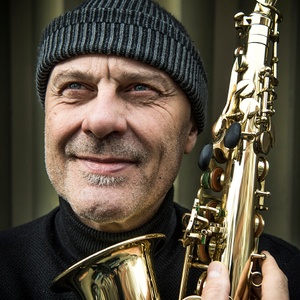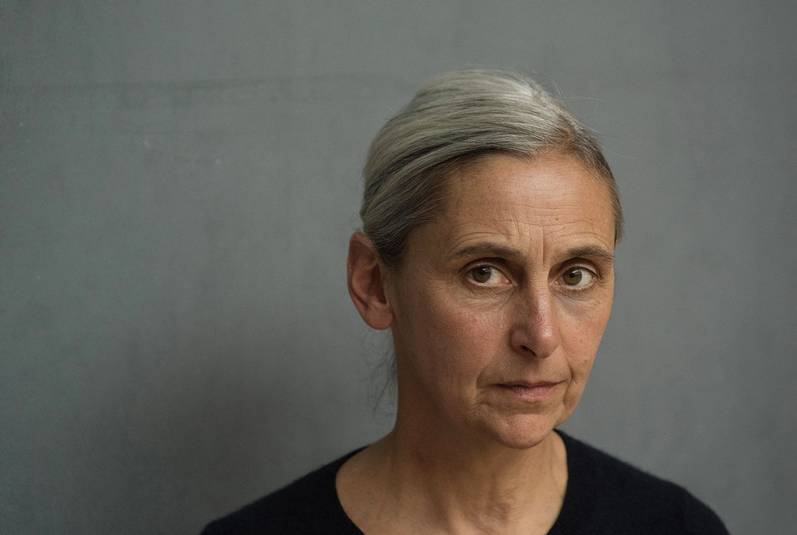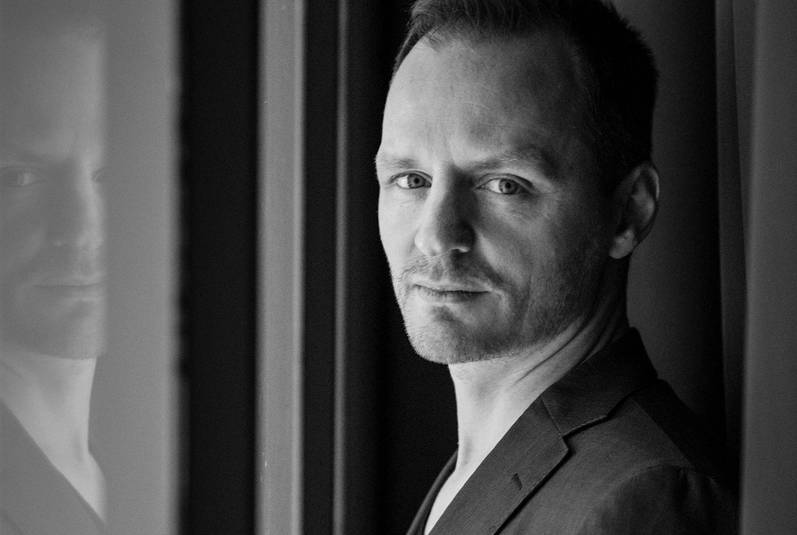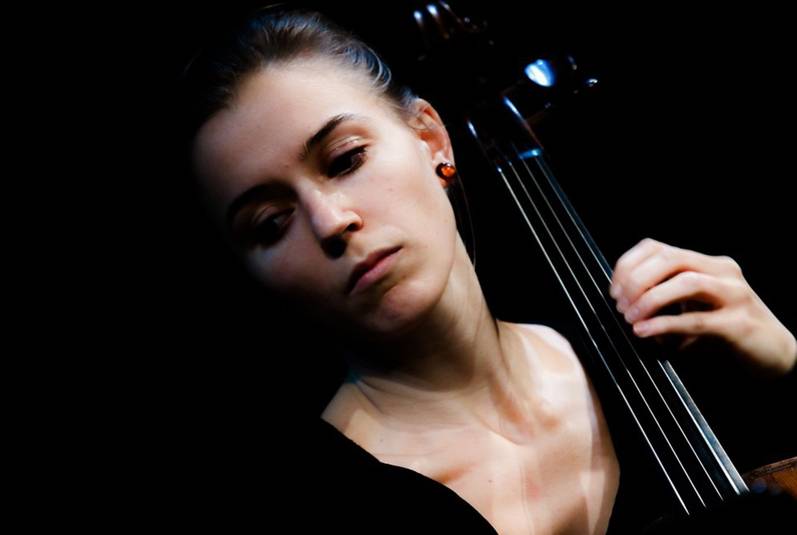Since its foundation three decades ago, BL!NDMAN was guided almost as much by the heritage of iconoclasts like Marcel Duchamp and Joseph Beuys as it was by Bach or the American minimalists. “I will always be a sponge,” founder Eric Sleichim says. “But at the same time, I want to continue rooting in the soil from which I sprang.”
© Saskia Vanderstichele
Eric Sleichim (60) found the name of his ensemble – initially a saxophone quartet and later a collective consisting of quartets of various groups of instruments, but first and foremost a vision – in a Dadaist dictionary. The Blind Man was the name of a periodical of which Marcel Duchamp only published two issues in New York in 1917. “But the idea behind it was beautiful: a blind guide who explains artworks to sighted viewers in a museum. It was the perfect metaphor for what I wanted to do with music on a stage, namely to reveal something of the sound world that I experienced day and night in my head.”
Incidentally, he has always been fascinated by blind musicians, Sleichim (a palindrome of Michiels) tells us at his rehearsal space in De Bottelarij in Molenbeek. “Their sixth sense gives their music an extra dimension.” He also tells us about how the performance Wie man dem toten Hasen die Bilder erklärt ( How one explains the paintings to a dead hare ) by German artist Joseph Beuys made an overwhelming impression on him. “With a gilded head and his eyes closed, he beheld the world. I based one of my first solo movements for tenor sax on that poetic image.”
I am still absolutely astonished when I see a 15-year-old solder-ing electrical wires to generate sound, in an attempt to reinvent the world

This sensibility for the broader arts scene and the world might help to explain why director Ivo Van Hove of Toneelgroep Amsterdam always comes knocking when he is adapting the great playwrights, why Sleichim’s quartets appear on renowned stages with the Comédie-Française or the National Theatre, and why his music will soon also feature in a musical theatre production with visual artist Hans Op de Beeck. But first, the Kaaitheater is hosting a retrospective of thirty years of BL!NDMAN. With pieces by Maximalist!, which was the precursor to the collective in the fertile Brussels wasteland of the 1980s. With compositions by Steve Reich, Philip Glass, and Terry Riley, who will be honoured later this year with the new album Icons. American Minimal Music , the tenth to date. And of course also with the typical BL!NDMAN adaptations of iconic older work, by Bach and Handel, embellished for the occasion with festive Decap organs.

BL!NDMAN’s eyewitness
‘Shall we call it passion?’
ANNE TERESA DE KEERSMAEKER
CHOREOGRAPHER
The young Eric Sleichim had never heard of Anne Teresa De Keersmaeker when he was asked to contribute to the music of the first quartet piece (and the international breakthrough) of the Brussels-based choreographer. Rosas danst Rosas (1983) was the beginning of the adventure. Anne Theresa De Keersmaeker: “Maximalist! became the rock band of Rosas danst Rosas. Their music came with an apparent opposition. These were classically trained musicians who loved jazz, but there was also a link with pop and rock ‘n’ roll. They combined an intense fascination with structure with the beat, the swing, the energy, and the anarchy of punk. Later on, Eric continued to make connections with BL!NDMAN: the old and the modern, the classical canon and the contemporary. He has been very actively engaged to transfer his knowledge – shall we call it passion? – to younger generations. By emphasizing the speaking voice of the saxophone, he has also made very clear what a special instrument it is. I still regret never having seen a live performance of BL!NDMAN plays Bach, his saxophone quartet’s unconventional interpretation of Bach’s Chorale Partita.” De Keersmaeker also mentions how Sleichim combined theatre, dance, and music in his compositions. “The scores he wrote for Ivo Van Hove are an art in themselves. Writing music that pushes things forward in the right proportion, creating a counterpoint to visual information, is a very difficult balancing act, but in his sound score for Ivo’s The Damned, it was perfect.”
What is BL!NDMAN actually: a quartet, a collective, or perhaps a kind of school or a vision? In other words, what is the link between all these projects?
Eric Sleichim: Curiosity? I have always been a sponge. With Maximalist!, we already listened to both Josquin des Prez and Monteverdi, both Prince and Jimi Hendrix, both Ligeti and Xenakis. They all influenced our music. And that is no different with BL!NDMAN. In the early years, I especially looked for a new way to approach classical music. What began as a saxophone quartet gradually became its own habitat, with a string quartet, a percussion quartet, and even a vocal (now hybrid) quartet. Thanks to that combination of generations and families of instruments, we became a collective. Nevertheless, every quartet remains an organism in itself. This makes our formula unique. It is not like in jazz, where you have a drum, a piano, a bass, and a sax. No, it stays in the same family, so our contemporary approach is still aligned with the western classical tradition.
Did you have to rebel as a teenager to be able to discover all these sounds?
Sleichim: No, I had the great fortune that I was never forced to suffer through restrictive education, partly because I went to boarding school from the age of seven. I soon found kindred spirits at the Athenaeum Irishof in Kapellen. We used to play in rock bands together. We were allowed to do what we liked, and I have never stopped. I went to music school primarily to deconstruct the protocols of classical music. I was not interested in playing Mozart and Haydn properly. I thought their music was just as interesting as that of Jimi Hendrix or Cecil Taylor. Actually, The Beatles were my first teachers, later followed by Rory Gallagher, Jimi Hendrix, and Alvin Lee’s solos, and symphonic rock, and Tangerine Dream, Tubular Bells, and Stockhausen. Via electronic music, the step to contemporary music was smaller than to classical music. I never wanted to conform, but trained myself in a very eclectic, messy, explosive way, through encounters and coincidences.
Running into your Maximalist! colleague Peter Vermeersch at a Sun Ra concert at La Raffinerie, illustrates that intuitive trajectory.
Sleichim: Yes, actually I had first met him slightly earlier in the dressing rooms at the Vooruit in Ghent. I was playing there with Luna Twist, and his rock band Union were the warm-up act. The fact that we ran into each other three days later at Sun Ra was indeed an unbelievable coincidence and it marked the beginning of my career because he had just been asked to write the music for Rosas danst Rosas by Anne Teresa De Keersmaeker. That is how the interdisciplinary cross-fertilization began. I wanted to see and understand everything, and apply it immediately. For thirty years, BL!NDMAN has been the constant application of my curiosity.

BL!NDMAN’s eyewitness
‘We share an architectural vision of art’
HANS OP DE BEECK
VISUAL ARTIST
If you look at BL!NDMAN’s performance schedule, it looks as though they spend most of their time accompanying musical theatre productions. That is because the success of these pieces means that they are reprised often, and new ones are regularly added. At the beginning of May, for example, The Valley (an apocalypse) will première at deSingel, their first production with Hans Op de Beeck. “About ten years ago, when I first met Eric at Flagey, he said that he wanted to collaborate with me,” says the Brussels-based visual artist who has become increasingly active in the performing arts over the past few years. “I am happy that as a director, scriptwriter, and set designer, I can now manage a complete package again, because this fits well with my artistic practice.” Just like Sleichim, Op de Beeck likes to think about the position of the musicians on the stage. “We share an architectural vision of art. In this piece, the musicians float behind actor Dirk Roofthooft like masters of ceremony or guardian angels, in what is literally an arena. I am very much guided by intuition and felt an immediate rapport with Eric. Because my work is not illustrative or anecdotal, we had agreed to make the music and text separately, to unite them later as two parallel worlds. It was the right choice because just like earlier collaborations with Pieter De Buysser and Sidi Larbi Cherkaoui, I feel during the rehearsals as though everything develops in a very organic, serene way, without any conflicts.”
With the saxophone as the primordial driving force?
Sleichim: Yes, I have always loved the architecture and the mechanics of the instrument. With all those keys, I really thought of it as a sound factory, much more complex than the guitar that I had played in my rock bands. But there was no repertoire that appealed to me. We had to develop our own language. We soon found our way to John Cage, who also approached chamber music as an iconoclast. In the 1940s, he was already putting ping-pong balls and elastic bands inside his piano, to create a new sound universe. I applied that attitude to the saxophone quartet. I literally disassembled my instrument, listened to all the levers and keys, the reed, the spit and the air. After ten years of experimental work, we went back to the classical repertoire, and I rediscovered Bach. As a result, we were immediately in higher demand, even internationally, and BL!NDMAN had an incredibly eclectic career.
The result is that after thirty years, BL!NDMAN is now part of the establishment. Does that not clash with the rebel whose career once began in a squat?
Sleichim: Certainly, it is a very difficult balancing act. It is true that for the first ten years, I squatted in a building in the Prins Boudewijnkazerne/Caserne Prince Baudouin on Daillyplein/place Dailly in Anderlecht. We could rehearse there for free. We simply split the takings from our concerts by five – four musicians and a manager.
Now that we are certified and subsidized, and declare all our earnings, almost half of what we make goes to the organization of that certification. In a certain sense, we are thus sawing through the branch on which we sit. That is why trying to stay connected to the soil, to where we come from, is one of the most important challenges for the coming years. I spend much more time thinking now about the question of the significance of ensembles like BL!NDMAN, but also our colleagues in Ictus, ChampdAction, or SPECTRA for the new generation. What is our social relevance?
Listening to what is happening on the street remains essential for us. We must not lose our function as a laboratory. At the HISK in Ghent, we continue to bring young composers with a clean slate together with young artists in other fields. For myself too, I do not want to opt for the easy solutions. I want to continue treading on my own toes. That is not always easy for an old fart like me. But I am still absolutely astonished when I see a 15-year-old soldering electrical wires to generate sound, in an attempt to reinvent the world.

BL!NDMAN’s eyewitness
'The sky is the limit’
SUZANNE VERMEYEN
CELLIST
Cellist Suzanne Vermeyen (31) had founded her own string quartet called the Quatuor Alcea in 2013, which performed both classical and contemporary repertoires. But when Eric Sleichim asked whether they wanted to join the BL!NDMAN collective a few years ago, she didn’t think twice. “Because there were some big fans in my family, I had known his work since I was a teenager,” she says. Their first big project as BL!NDMAN [strings] was to write the music to accompany the play Een klein leven (based on Hanya Yanagihara’s popular novel A Little Life) by Toneelgroep Amsterdam, which is being reprised this month. Vermeyen thinks it is an amazing experience but also very relaxed to participate as a quartet in such an oiled machine that acts at the very highest level. She will also be part of the show at the Kaaitheater and record the new CD (with Steve Reich’s Triple Quartet). Over the past few years, she has been particularly impressed by Sleichim’s positivity and drive. “He is a dreamer with endless ideas. Sometimes he has to be restrained because they are almost impossible to realize, or there is no time or budget, but to him, the sky is the limit. He can go for something two hundred percent, without topping. When we joined the collective, I expected us to be asked to take part in certain performances and that there would otherwise be little contact, but it became an intimate collaboration. Eric has a great sense of responsibility for everything that happens under the BL!NDMAN banner and insists on planning everything and making decisions together.”
> BL!NDMAN: MINIMAL-MAXIMAL & WATER & FIRE/HANDEL REVISITED. 6/4, 20.30, Kaaitheater
Read more about: Muziek
Fijn dat je wil reageren. Wie reageert, gaat akkoord met onze huisregels. Hoe reageren via Disqus? Een woordje uitleg.